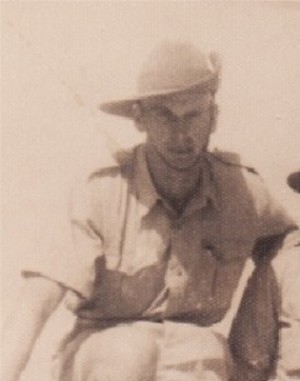Service Details
- Branch of Service
- Army
- Conflict
- World War II (1939-1945)
- Date of Enlistment
- 23/08/1940
- Date of Discharge
- 27/11/1945
- Place of Enlistment
- Goulburn NSW
Personal Details
- Gender
- Male
- Other Name(s)
- Nicknamed 'Toc'
- Date of Birth
- 22/08/1917
- Place of Birth
- Michelago NSW
- Address (at enlistment)
- Malbon Street, Bungendore NSW (previously Kingston ACT)
- School(s) Attended
- St. Mary's Catholic School, Bungendore NSW
- Occupation
- Postal employee
- Next of Kin
- James Hourigan (father), Malbon Street, Bungendore NSW
Unit and Rank Details
- Service Number
- NX60675
- Final Rank
- Private
- Final Unit
- 2/13 Battalion
Notes
'Toc' Hourigan was raised in Bungendore and started working for the Postmaster General's office in Canberra in 1938. He boarded in Kingston until shortly before enlisting in August 1940. After training at Tamworth he embarked for the Middle East in April 1941 with reinforcements for the 20th Brigade, which was part of the 9th Division of the second AIF, arriving in Egypt on 3 May 1941. He was allocated to the 2/17 Battalion and became one of the Rats of Tobruk when the Germans laid siege to the port. His older brother Bill was also at Tobruk, serving with the 2/13 Battalion. He 'claimed' his brother and Hourigan transferred to the 2/13 Battalion.
Toc often spoke to his family of the conditions endured by the men of Tobruk, the regular air raids by the Stukas, the night time patrols beyond the wire into enemy territory to gain intelligence on the location of units and the general lay of the ground, about the lack of fresh water and the flies and poor rations. He was eventually evacuated to hospital in Egypt with enteric.
After recovering Hourigan trained as a signaller before joining the 2/13 Battalion in January 1942. In July 1942 the 9th Division was moved to El Alamein as part of the defence of Egypt against the German Afrika Corps. The 2/13 Battalion fought in the Battle of El Alamein from 23 October to 5 November 1942. Toc remembered the fierceness of that battle, particularly the artillery. His Commanding officer spoke to him and one of his signaller mates, shaking their hands, and wishing them well for the forthcoming battle just prior to its commencement. The C.O. was himself to be killed a short time later, as a result of the artillery. Hourigan also had numerous near misses from German shelling, on one occasion being buried by a shell burst and dug out by his mates.
The 9th Division returned to Australia in January 1943 to face the threat from the Japanese. Hourigan and his unit were sent first to Milne Bay, on the eastern tip of Papua, in July 1943. On 4 September 1944 they left Milne Bay and made a sea-borne landing at Red Beach near Lae in New Guinea. After Lae was captured on 12 September the 2/13 Battalion took part in the landings at Scarlet Beach near Finschhafen ten days later. Shortly afterwards Toc was evacuated to a tent hospital near Port Moresby. While there the Japanese bombed the hospital and as there was no protection the patients and staff had to lay flat on the ground. One man panicked, stood up and started to run but sadly he was killed by shrapnel. Hourigan also had to shave a fellow patient who had been shot through the lung because the man was too weak to do it himself. He rejoined his unit six weeks later and they returned to Australia in March 1944, but over the next six months he was twice hospitalised with malaria.
Until they embarked for Morotai in April 1945, the men of the 2/13 Battalion were based at Ravenshoe in northern Queensland. It was idyllic, especially compared to the desert of North Africa and the New Guinea jungle with what Hourigan regarded as the most even climate anywhere in Australia. From Morotai, Hourigan and the 2/13 Battalion landed at Brunei in northern Borneo on 10 June 1945, fighting the Japanese in operations to capture oilfields before reaching the town of Lobang where they were positioned when the war ended.
Toc Hourigan returned to Australia in November 1945 and was discharged on 27 November 1945. He moved back to Canberra in 1946 and worked for the airline TAA after the war. He was one of the first residents in Miller Street, O'Connor when he and his family moved there in February 1949. Because of war associated illness, Hourigan retired from TAA in 1966 and died at home on 31 May 1986 aged 69 years. Terence 'Toc' Hourigan is buried in Gungahlin Cemetery. His son Ron served in the Royal Australian Navy during the Vietnam War.
Sources
WWII Nominal Roll http://www.ww2roll.gov.au
ACT Electoral Rolls 1916 to 1967 http://canberraheritageportal.org/default.php
NAA RecordSearch - Series B883 (Second Australian Imperial Force Personnel Dossiers, 1939-1947)
The Canberra Times - 2 June 1986
Nomination 28 August 2015 by his son, Ronald Hourigan as well as additional information and image provided 30 September 2015
